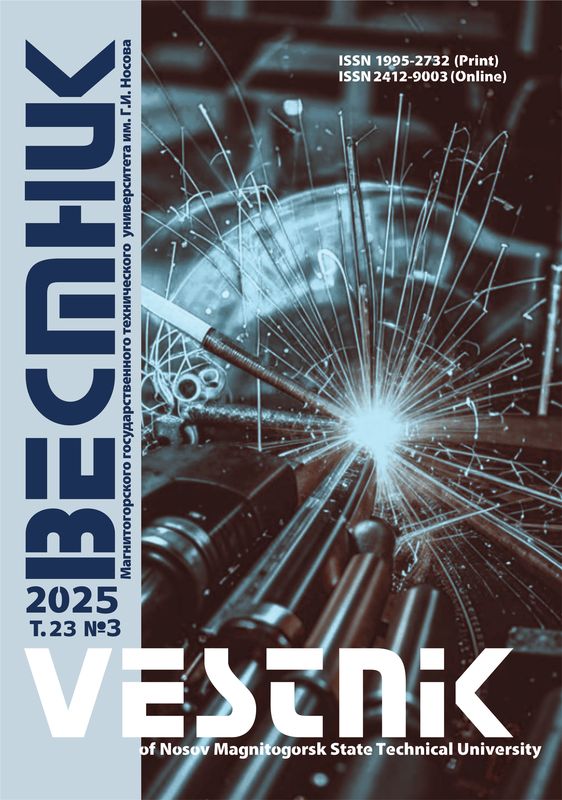DOI: 10.18503/1995-2732-2020-18-2-38-46
Abstract
The process of wire-arc additive manufacturing (WAAM) is a new method for the direct manufacturing of components by melting and applying a layer of filler wire layer by layer with an arc as a power source. Aluminum alloy 1580, an experimental magnesium-containing alloy, containing 0.1% of scandium introduced as an alloying element to significantly increase strength, has wide prospects for its use in the aerospace industry due to its high strength-to-weight ratio and good mechanical properties. The use of WAAM technology for manufacturing products from high-strength aluminum alloys attracted the attention of the aerospace industry. However, metal produced by the arc welding pro-cess has high residual stresses, an unfavorable microstructure leading to low mechanical properties. It is proved that heat treatment, such as annealing, improves the properties of WAAM Al-6.3Cu components. Aluminum alloy 1580 can also be hardened by heat treatment, and its properties vary depending on the processing temperature and time. In this study, thin-walled aluminum alloy 1580 samples were manufactured using WAAM. To carry out heat treatment of the samples, they were annealed at various temperatures and time. The authors studied a microstructure and mechanical properties of the samples annealed under various conditions. The paper contains the results of mechanical testing of the samples. It is found that heat treatment influences the microstructure and mechanical properties of the alloy 1580 samples.
Keywords
Additive technologies, multilayer surfacing, cold metal transfer, aluminum, scandium, heat treatment, annealing, mechanical properties, tensile properties, microstructure, wire arc additive manufacturing, arc welding.
For citation
Kartashev M.F., Yurchenko A.N., Grebenkin R.D., Mindibaev M.R., Permyakov G.L., Trushnikov D.N. Studying the Heat Treatment Effect on the Microstructure and Mechanical Properties of Aluminum Magnesium-Containing Alloy 1580 Samples Produced by a Multilayer Surfacing Method. Vestnik Magnitogorskogo Gosudarstvennogo Tekhnicheskogo Universiteta im. G.I. Nosova [Vestnik of Nosov Magnitogorsk State Technical University]. 2020, vol. 18, no. 2, pp. 38–46. https://doi.org/10.18503/1995-2732-2020-18-2-38-46
1. S. Williams, F. Martina, A. Addison, J. Ding, G. Pardal, P. Colegrove. Wire + arc additive manufacturing. J. Mater. Sci. Technol. 32 (2016), 641–647, https://doi. org/10.1179/1743284715Y.0000000073.
2. T. DebRoy, H. Wei, J. Zuback, T. Mukherjee, J. Elmer, J. Milewski, A. Beese, A. Wilson-Heid, A. Ded, W. Zhang. Additive manufacturing of metallic components – process, structure and properties, progress in materials. Science, 92 (2018), 112–224, https://doi.org/10.1016/j.pmatsci.2017.10.001.
3. D. Ding, A. Pan, D. Criuri, H. Li. Wire-feed additive manufacturing of metal components: technologies, developments and future interests. Int. J. Adv. Manuf. Technol. 81 (2015), 465–481, https://doi.org/10.1007/s00170-015-7077-3.
4. Zewu Qi, Baoqiang Cong, Bojin Qi, Gang Zhao, Jialuo Ding. Properties of wire + arc additively manufactured 2024 aluminum alloy with different solution treatment temperature. Materials Letters, Volume 230, 2018, pp. 275–278, ISSN 0167-577X, https://doi.org/10.1016/j.matlet.2018.07.144.
5. P. Naga Raju, K. Srinivasa Rao, G.M. Reddy, M. Kamaraj, K. Prasad Rao. Mater. Sci. Eng. A 464 (2007), 192–201.
6. Baranov V. et al. Study of strength properties of semi-finished products from economically alloyed high-strength aluminum-scandium alloys for application in automobile transport and shipbuilding. Open Engineering, 2018. vol. 8, no. 1, pp. 69–76.
7. Shchitsyn Yu. D. et al. Plasma surfacing for additive formation of semi-finished products from aluminum alloys. Vestnik Permskogo natsionalnogo issledovatelskogo politekhnicheskogo universiteta. Mashinostroenie, materialovedenie [Bulletin of PNRPU. Mechanical engineering, materials science], 2019, vol. 21, no. 2, pp. 63–72. (In Russ.)
8. Belov N. A., Alabin A. N. Advanced aluminum alloys with added zirconium and scandium. Tsvetnye metally [Ferrous Metals], 2007, no. 2, pp. 99–106. (In Russ.)
9. Belov N. A., Alabin A. N., Prokhorov A. Yu. Effect of added zirconium on strength and electrical resistance of cold rolled aluminum sheets. Izvestiya vysshikh uchebnykh zavedenii. Tsvetnaya metallurgiya. [Universities’ Proceedings. Non-Ferrous Metallurgy], 2009, no. 4, pp. 42–47. (In Russ.)
10. J. Gu, J. Ding, S. Williams, H. Gu, J. Bai, Y. Zhai, P. Ma. The strengthening effect of inter-layer cold working and post-deposition heat treatment on the additively manufactured Al-6.3Cu alloy. Mater. Sci. Eng. A 651 (2016), 18–26.
11. J. Bai, C. Fan, S. Lin, C. Yang, B. Dong. Mechanical properties and fracture behaviors of GTA-additive manufactured 2219-Al after an especial heat treatment. J. Mater. Eng. Perform. 26 (2017), 1808–1816. https://doi.org/ 10.1007/s11665-017-2627-5.
12. Baoqiang Cong, Zewu Qi, Bojin Qi, Hongye Sun, Gang Zhao and Jialuo Ding. A comparative study of additively manufactured thin wall and block structure with Al-6.3%Cu alloy using cold metal transfer process. Appl. Sci. 2017, 7, 275.












